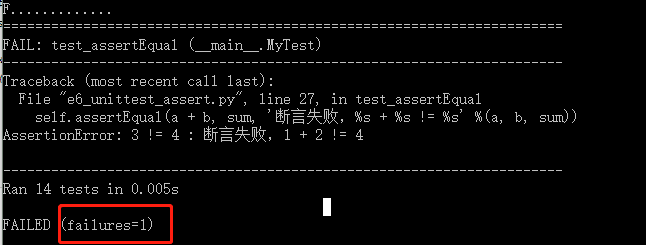unittest中包含了很多断言内容,实际用到的断言内容也就比对值是否相同,下面是unittest中的断言内容
#encoding=utf-8
import unittest
import random
# 被测试类
class MyClass(object):
@classmethod
def sum(self, a, b):
return a + b
@classmethod
def div(self, a, b):
return a / b
@classmethod
def retrun_None(self):
return None
# 单元测试类
class MyTest(unittest.TestCase):
# assertEqual()方法实例
def test_assertEqual(self):
# 断言两数之和的结果
a, b = 1, 2
sum = 4
self.assertEqual(a + b, sum, '断言失败,%s + %s != %s' %(a, b, sum))
# assertNotEqual()方法实例
def test_assertNotEqual(self):
# 断言两数之差的结果
a, b = 5, 2
res = 1
self.assertNotEqual(a - b, res, '断言失败,%s - %s != %s' %(a, b, res))
# assertTrue()方法实例
def test_assertTrue(self):
# 断言表达式的为真
self.assertTrue(1 == 1, "表达式为假")
# assertFalse()方法实例
def test_assertFalse(self):
self.assertFalse(3 == 2, "表达式为真")
# assertIs()方法实例
def test_assertIs(self):
# 断言两变量类型属于同一对象,这事对比的地址,查看地址使用id(变量)
a = 12
b = a
self.assertIs(a, b, "%s与%s不属于同一对象" %(a, b))
# test_assertIsNot()方法实例
def test_assertIsNot(self):
# 断言两变量类型不属于同一对象
a = 12
b = "test"
self.assertIsNot(a, b, "%s与%s属于同一对象" %(a, b))
# assertIsNone()方法实例
def test_assertIsNone(self):
# 断言表达式结果为None
result = MyClass.retrun_None()
self.assertIsNone(result, "not is None")
# assertIsNotNone()方法实例
def test_assertIsNotNone(self):
result = MyClass.sum(2, 5)
self.assertIsNotNone(result, "is None")
# assertIn()方法实例
def test_assertIn(self):
# 断言对象A是否包含在对象B中 ,这就是in的一个用法
strA = "this is a test"
strB = "is"
self.assertIn(strB, strA, "%s不包含在%s中" %(strB, strA))
# assertNotIn()方法实例
def test_assertNotIn(self):
strA = "this is a test"
strB = "Selenium"
self.assertNotIn(strB, strA, "%s包含在%s中" %(strB, strA))
# assertIsInstance()方法实例
def test_assertIsInstance(self):
# 测试对象A的类型是否值指定的类型
x = MyClass
y = object
self.assertIsInstance(x, y, "%s的类型不是%s" %(x, y))
# assertNotIsInstance()方法实例
def test_assertNotIsInstance(self):
# 测试对象A的类型不是指定的类型
a = 123
b = str
self.assertNotIsInstance(a, b, "%s的类型是%s" %(a, b))
# assertRaises()方法实例
def test_assertRaises(self):
# 测试抛出的指定的异常类型
# assertRaises(exception)
with self.assertRaises(TypeError) as cm:
random.sample([1,2,3,4,5], "j")
# 打印详细的异常信息
self.assertRaises(ZeroDivisionError, MyClass.div, 3, 0)
# assertRaisesRegexp()方法实例
def test_assertRaisesRegexp(self):
# 测试抛出的指定异常类型,并用正则表达式具体验证
with self.assertRaisesRegex(ValueError, 'literal') as ar:
int("xyz")
# assertRaisesRegexp(exception, regexp, callable, *args, **kwds)
self.assertRaisesRegex(ValueError, "invalid literal for.*XYZ'$", int, 'XYZ')
if __name__ == '__main__':
# 执行单元测试
unittest.main()
测试结果,运行14个,失败了1个,失败的结果显示
